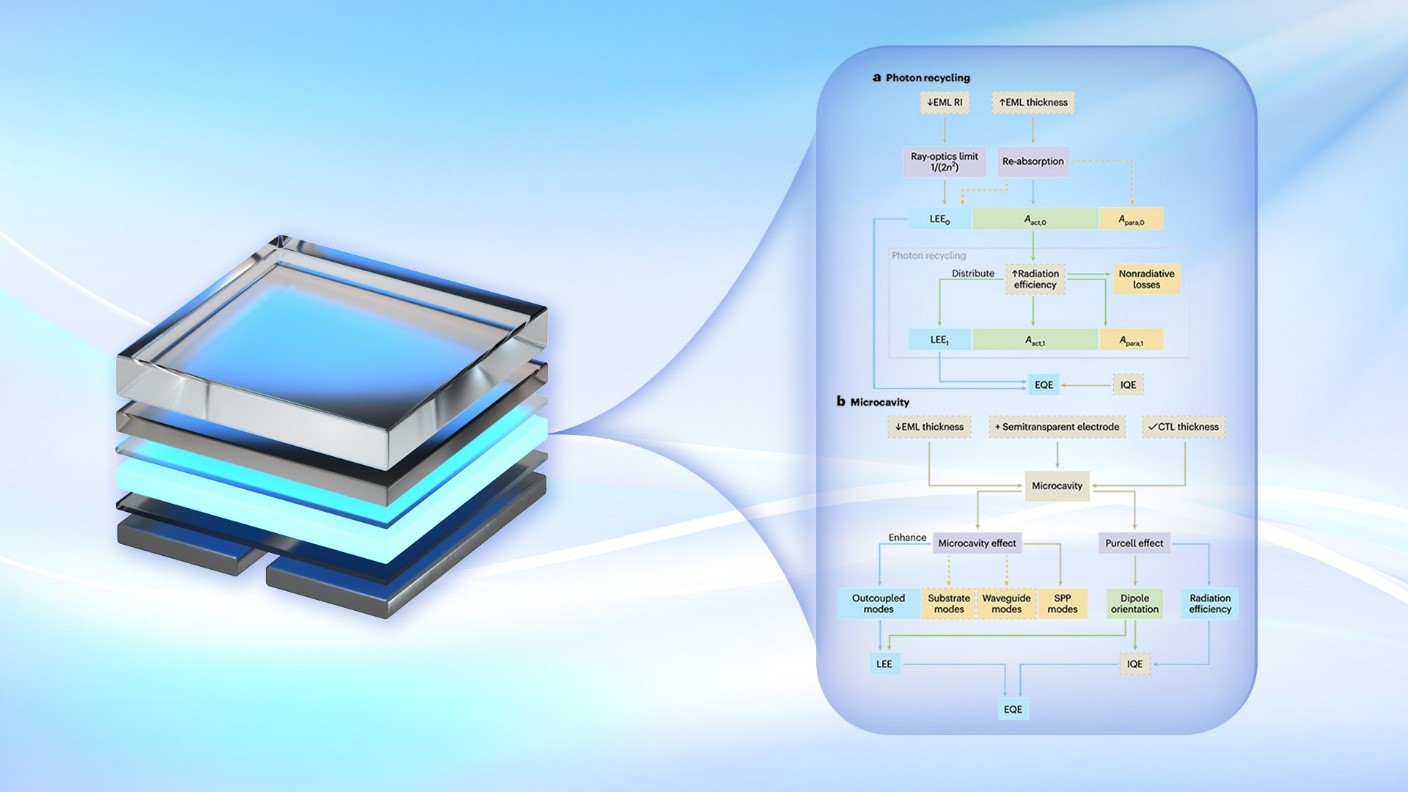In the fields of perovskite light-emitting diodes (PeLEDs) and quantum dot light-emitting diodes (QLEDs), recent advanced studies have achieved a high efficiency that significantly surpassed the efficiency limit of ray optics. The mainstream view attributes the breakthrough to photon recycling, with some suggesting that photon recycling can help PeLEDs to achieve 100% light extraction efficiency (LEE).

A research team led by Chair Professor Xiao Wei Sun from the Institute of Nanoscience and Applications and the Department of Electronic and Electrical Engineering (EEE) at the Southern University of Science and Technology (SUSTech), along with Professor Kai Wang from the Department of EEE, have recently published a paper that clarifies the theoretical reasons behind these efficiency breakthroughs. They point out that the main reason for these breakthroughs is the microcavity and the effect of photon recycling is exaggerated in some cases.
Their work, entitled “Competing light extraction strategies in perovskite light-emitting diodes”, has been published in the journal Nature Nanotechnology.
Due to significant photon recycling and microcavity effect within PeLEDs, the ray-optics model should no longer be used to evaluate LEE, as it can severely overestimate the internal quantum efficiency (IQE). The paper points out that while photon recycling can potentially enhance efficiency, it actually inhibits microcavity effect, which is a primary reason for high efficiency in PeLEDs. The study indicates that enhancing photon recycling could potentially reduce efficiency by sacrificing microcavity effect.
This work is the first to clearly demonstrate the competitive relationship between photon recycling and microcavity effect, providing a path for optimizing LEE in PeLEDs and preventing future research from following the misleading efficiency limit. Since both quantum dots and perovskite materials have larger refractive indices than organic semiconductors (in OLEDs), the conclusions of this study are also applicable to QLEDs.

Figure 1. The flow diagrams of photon recycling and the microcavity effect show the interrelations of various effects
Due to the small Stokes shift of perovskite materials, there is re-absorption and re-emission inside PeLED, which is called photon recycling. It redirects photons from trapped to outcoupled modes, thereby enhancing efficiency. Photon recycling provides an explanation for the current high-efficiency PeLED. In the photon recycling process shown in Figure 1a, LEE is accumulated in each round of recycling, but at the same time, energy is redistributed to non-radiative recombination and parasitic absorption, thereby amplifying losses. For example, in the case of Figure 2d, when the internal quantum efficiency (IQE) drops by 10%, the efficiency will decay to half of the original. In other words, the photon recycling strategy is very sensitive to loss. To achieve high efficiency through photon recycling, parasitic absorption should be avoided, and the radiation efficiency must be near unity, which is difficult to achieve in practice.

Figure 2. Efficiency analyses of photon recycling and microcavity
Since the refractive index of the perovskite is higher than that of the organic material in OLEDs, PeLED has a stronger microcavity effect. The simulation results (Figure 2ef) show that the LEE in PeLED is heavily dependent on the microcavity effect. Based on the enhanced microcavity effect, an efficiency of ~50% can be achieved. However, the photon recycling strategy suggests increasing the thickness of the light-emitting layer, which will inhibit the formation of a good microcavity (Figure 1b), resulting in the attenuation of the microcavity effect and the Purcell effect. From this perspective, photon recycling is not beneficial for efficiency improvement.
In summary, there is a competitive relationship between the photon recycling strategy and the microcavity strategy. Photon recycling needs to meet strict prerequisites to effectively contribute photons, and the microcavity effect will be sacrificed in the process. Therefore, the photon recycling strategy cannot guarantee efficiency improvement in practice and may even reduce efficiency. In most cases, the microcavity effect should be given priority. To achieve an efficiency breakthrough, we should choose an appropriate light extraction strategy based on the characteristics of materials and devices. This study points out the direction of the PeLED efficiency breakthrough.
Dr. Guanding Mei from SUSTech is the first author of the paper. Professor Xiao Wei Sun is the corresponding author, and SUSTech is the sole corresponding institution.
This research was supported by the Ministry of Science and Technology of China and the National Natural Science Foundation of China.
Paper link: https://www.nature.com/articles/s41565-024-01709-y
To read all stories about SUSTech science, subscribe to the monthly SUSTech Newsletter.
Proofread ByAdrian Cremin, Yingying XIA
Photo ByDepartment of Electronic and Electrical Engineering